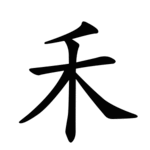| 禾 | ||||
|---|---|---|---|---|
| ||||
| 禾 (U+79BE) "grain" | ||||
| Pronunciations | ||||
| Pinyin: | hé | |||
| Bopomofo: | ㄏㄜˊ | |||
| Gwoyeu Romatzyh: | her | |||
| Wade–Giles: | ho | |||
| Cantonese Yale: | wòh | |||
| Jyutping: | wo4 | |||
| Japanese Kana: | カ ka (on'yomi) いね ine (kun'yomi) | |||
| Sino-Korean: | 화 hwa | |||
| Names | ||||
| Chinese name(s): | 禾字旁 hézìpáng | |||
| Japanese name(s): | 禾/いね ine (Left) 禾偏/いねへん inehen (Informal) ノ木/のぎ nogi (Left, informal) ノ偏/のぎへん nogihen | |||
| Hangul: | 벼 byeo | |||
| Stroke order animation | ||||
 | ||||
Radical 115 or radical grain (禾部) meaning "grain" is one of the 23 Kangxi radicals (214 radicals in total) composed of 5 strokes.
In the Kangxi Dictionary, there are 431 characters (out of 49,030) to be found under this radical.
禾 is also the 111th indexing component in the Table of Indexing Chinese Character Components predominantly adopted by Simplified Chinese dictionaries published in mainland China.
Evolution
-
 Oracle bone script character
Oracle bone script character
-
 Bronze script character
Bronze script character
-
 Large seal script character
Large seal script character
-
 Small seal script character
Small seal script character
Derived characters
| Strokes | Characters |
|---|---|
| +0 | 禾 |
| +2 | 禿 秀 私 秂 秃 (=禿) |
| +3 | 秄 秅 秆 (=稈) 秇 秈 秉 秊 (=年 -> 干) |
| +4 | 秋 (also SC form of 鞦 -> 革) 秌 (=秋) 种 (also SC form of 種) 秎 秏 (=耗 -> 耒) 秐 科 秒 (=藐 -> 艸) 秓 秔 (=粳 -> 米) 秕 秖 秗 |
| +5 | 秘 秙 秚 秛 秜 秝 秞 租 秠 秡 秢 秣 秤 秥 秦 秧 秨 秩 秪 秫 秬 秭 秮 积 (=積) 称/称 (=稱) |
| +6 | 秱 秲 秳 秴 秵 秶 秷 秸 秹 秺 移 秼 秽 (=穢) 秾 (=穠) 稆 (=穭) |
| +7 | 秿 稀 稁 稂 稃 稄 稅 稇 稈 稉 (=粳 -> 米) 稊 程 稌 稍 税 (=稅) |
| +8 | 稏 稐 稑 稒 稓 稔 稕 稖 (=䎧 -> 耒) 稗 稘 (=萁 -> 艸) 稙 稚 稛 稜 稝 稞 稟 稠 稡 稢 稣 (=穌) 稤 稥 |
| +9 | 稦 稧 稨 稩 稪 稫 稬 (=糯 -> 米) 稭 (=秸) 種 稯 稰 稱 稲 (=稻) 稳 (=穩) 穊 |
| +10 | 稴 稵 稶 稷 稸 (=蓄 -> 艸) 稹 稺 (=稚) 稻 稼 稽 稾 (=稿) 稿 穀 穁 穂 (=穗) 穃 |
| +11 | 穄 穅 (=糠 -> 米) 穆 穇 穈 穋 穌 積 穎 穏 (=穩) 穐 (=秋) 穑 (=穡) 穒 |
| +12 | 穉 (=稚) 穓 穔 穕 穖 穗 穘 穙 穚 穛 穜 (=種) 穝 穞 (=穭) |
| +13 | 穟 穠 穡 穢 穣 (=穰) |
| +14 | 穤 (=糯 -> 米) 穥 穦 穧 穨 (=頹 -> 頁) 穩 穪 (=稱 苾 -> 艸) 穫 |
| +15 | 穬 穭 穮 穯 |
| +17 | 穰 穳 |
| +18 | 穱 |
| +19 | 穲 |
Literature
- Fazzioli, Edoardo (1987). Chinese calligraphy : from pictograph to ideogram : the history of 214 essential Chinese/Japanese characters. calligraphy by Rebecca Hon Ko. New York: Abbeville Press. ISBN 0-89659-774-1.
- Lunde, Ken (Jan 5, 2009). "Appendix J: Japanese Character Sets" (PDF). CJKV Information Processing: Chinese, Japanese, Korean & Vietnamese Computing (Second ed.). Sebastopol, Calif.: O'Reilly Media. ISBN 978-0-596-51447-1.
External links
| Chinese radicals according to the Kangxi Dictionary | |
|---|---|
| 1 stroke | |
| 2 strokes | |
| 3 strokes | |
| 4 strokes | |
| 5 strokes | |
| 6 strokes | |
| 7 strokes | |
| 8 strokes | |
| 9 strokes | |
| 10 strokes | |
| 11 strokes | |
| 12 strokes | |
| 13 strokes | |
| 14 strokes | |
| 15 strokes |
|
| 16 strokes | |
| 17 strokes |
|
| See also: Kangxi radicals | |
| Simplified Chinese characters radicals (indexing components) | |
|---|---|
| 1 stroke | |
| 2 strokes | |
| 3 strokes | |
| 4 strokes | |
| 5 strokes | |
| 6 strokes | |
| 7 strokes | |
| 8 strokes | |
| 9 strokes | |
| 10 strokes | |
| 11 strokes | |
| 12 strokes | |
| 13 strokes | |
| 14 strokes |
|
| 17 strokes |
|
| GF 0011-2009 Table of Indexing Chinese Character Components prescribes 201 principle indexing components and 100 associated indexing components (in brackets) used in Simplified Chinese. Not all associated indexing components are listed above. | |